History
It was built from 1562 for Baldassarre Lomellini, banker to King Philip II of Spain, to a design by Giovanni Ponzello, «chamber architect» of Genoa and designer of Palazzo Tursi, belonging to Niccolò Grimaldi, Baldassarre's son-in-law. Andrea Semino frescoed its halls with Roman stories. Of the original 16th-century façade, only the white marble portal by Taddeo Carlone survives today, bearing the inscription 'venturi non immemor aevi'. Its original appearance can be seen in engravings by Rubens of 1622. [1]
The palace changed hands as early as the end of the 500, first passing into the hands of the Salvago family and then in 1772 into the hands of Marquis Cristoforo Spinola, ambassador of the Republic of Genoa to France, who commissioned the Genoese Emanuele Andrea Tagliafichi, assisted by the famous French architect Charles De Wailly, to renovate it, in order to update its appearance according to the emerging neoclassicism. [2] The intervention, carried out starting in 1773, led to the creation of the sober and rigorous atrium, the porticoed courtyard that replaced the original garden, and the terrace above, adorned with classical-style pavilions. [3] The most famous work, however, was the so-called 'Salone del Sole', a magniloquent masterpiece of architecture and decoration, inspired by the Palace of Versailles on which De Wailly had worked. Its appearance was documented by four engravings by Louis Jean Desprez included in the plates of the entry 'Architecture' [4] of the 'Encyclopédie ou Dictionnaire raisonné des sciences, des arts et des métiers de Denis Diderot et d’Alembert, and became one of the most prestigious destinations of the Grand Tour, mentioned by Stendhal and Flaubert. [2] The salon was gutted by bombing in 1942, and later what remained of the original decorations was removed and never rebuilt.
After a decade of work, which led to the extension of the west wing and a renewed interior decoration in the French taste, Spinola, having moved to France, sold the building to Marquis Domenico Serra. In 1917 it was then purchased by the shipowner Tito Campanella, who established his offices there and lived on the second piano nobile.
Description
Today the first floor is open to the public, where it is possible to admire the so-called Sala degli zecchini with frescoes by Semino depicting Stories of Scipio from Titus Livius (in the vault, Scipio’s Continence, to the south, Burning of the Carthaginian Ships, to the west, Scipio allied with Massinissa sets fire to the camps of the Carthaginians and Siface and Scipio defeats the Carthaginians at the Campi Magni and takes Siface prisoner, to the north, Scipio refuses gifts, finally, to the east, Scipio after the taking of Cartagena honours with crowns Tiberius and Digitius and with the golden one Admiral Caius Lelius and Scipio meets Hannibal before the battle of Zama). On the second floor, a room with frescoes by Giovan Battista Castello il Bergamasco depicting Storie di Enea e Didone survives, [5] and a room of romantic taste painted in the early 19th century by Michele Canzio.

The Palazzo Brignole Sale or Palazzo Rosso is a house museum located in Via Garibaldi, in the historical center of Genoa, in Northwestern Italy. The palace is part of the UNESCO World Heritage Site Genoa: Le Strade Nuove and the system of the Palazzi dei Rolli. The rich art collection inside, along with the galleries of Palazzo Bianco and Palazzo Doria Tursi, is part of the Musei di Strada Nuova and consists of the works of artists of the caliber of Antoon van Dyck, Guido Reni, Paolo Veronese, Guercino, Gregorio De Ferrari, Albrecht Dürer, Bernardo Strozzi and Mattia Preti.

The Palazzo Angelo Giovanni Spinola is a palace located in Via Garibaldi, in the historical center of Genoa, in Northwestern Italy. It was one of the 163 Palazzi dei Rolli of Genoa, the selected private residences where the notable guests of the Republic of Genoa were hosted during State visits. On 13 luglio del 2006 it was included in the list of 42 palaces which now form the UNESCO World Heritage Site Genoa: Le Strade Nuove and the system of the Palazzi dei Rolli. Now owned by a bank, it is possible to visit the areas open to the public.

The Palazzo Doria or Palazzo Andrea e Gio. Batta Spinola is a palace located in Via Garibaldi, in the historical center of Genoa, in Northwestern Italy. It was one of the 163 Palazzi dei Rolli of Genoa, the selected private residences where the notable guests of the Republic of Genoa were hosted during State visits. On 13 luglio del 2006 it was included in the list of 42 palaces which now form the UNESCO World Heritage Site Genoa: Le Strade Nuove and the system of the Palazzi dei Rolli.

The Palazzo Spinola di Pellicceria, also known as Palazzo Francesco Grimaldi, is a palace located in piazza di Pellicceria in the historical center of Genoa, Northwestern Italy. The palace was one of the 163 Palazzi dei Rolli of Genoa, the selected private residences where the notable guests of the Republic of Genoa were hosted during State visits. On 13 luglio del 2006 it was added to the list of 42 palaces which now form the UNESCO World Heritage Site Genoa: Le Strade Nuove and the system of the Palazzi dei Rolli. It is currently owned by the Ministry of Cultural Heritage and Activities and Tourism and houses the National Gallery of Art in Palazzo Spinola.
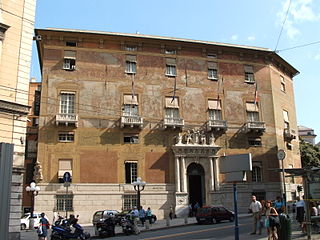
The Palazzo Doria-Spinola or Palazzo Antonio Doria is a palace located in largo Eros Lanfranco in the historical center of Genoa, Northwestern Italy. The palace was one of the 163 Palazzi dei Rolli of Genoa, one of those selected private residences where notable guests of the Republic of Genoa were hosted during State visits. On 13 luglio del 2006 it was added to the list of 42 palaces which now form the UNESCO World Heritage Site Genoa: Le Strade Nuove and the system of the Palazzi dei Rolli. The palace now hosts the Prefecture of Genoa and the seat of the Province of Genoa. It is possible to visit the areas of the building which are open to the public.
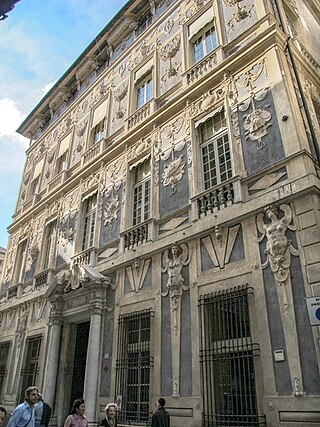
The palazzo Podestà or Nicolosio Lomellino is a building located in via Garibaldi (Genoa) at number 7 in the historical centre of Genoa, included on 13 July 2006 in the list of the 42 palaces inscribed in the Rolli di Genova that became World Heritage by UNESCO on that date.

The palazzo Pantaleo Spinola or palazzo Gambaro is a building located in via Garibaldi (Genoa) at number 2 in the historical centre of Genoa, included on 13 July 2006 in the list of the 42 palaces inscribed in the Rolli di Genova that became World Heritage by UNESCO on that date. The building is now the headquarters of the Banco di Chiavari e della Riviera Ligure.

The Palazzo Lercari-Parodi or Palazzo Franco Lercari is a building located at number 3, Via Garibaldi in the historical centre of Genoa, included on 13 July 2006 in the list of the 42 palaces inscribed in the Rolli di Genova that became World Heritage by UNESCO on that date.
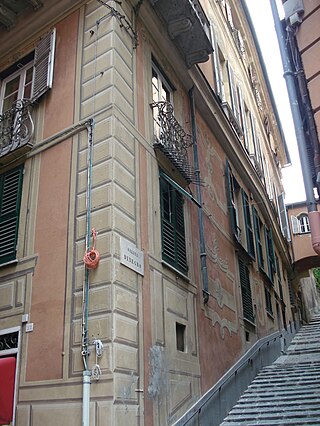
The palazzo Giorgio Spinola is a building located in Salita Santa Caterina|salita di Santa Caterina at no. 4 in Genoa, included on 13 July 2006 in the list of the 42 palaces inscribed in the Rolli di Genova that became World Heritage by UNESCO on that date.
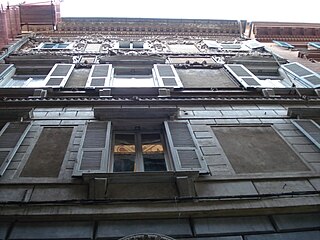
The Palazzo Tommaso Spinola, also known as Palazzo Tomaso Spinola di Luccoli or Palazzo Spinola Pessagno, is a building located in salita di Santa Caterina at number 3 in Genoa, included on 13 July 2006 in the list of the 42 palaces inscribed in the Rolli di Genova that became World Heritage by UNESCO on that date.
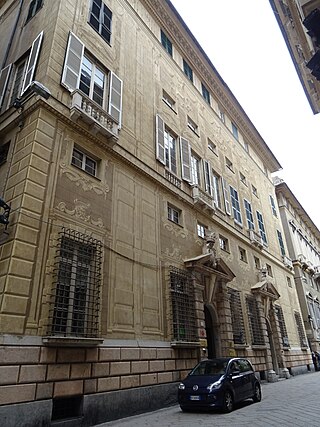
The palazzo Cattaneo-Adorno or palazzo Lazzaro e Giacomo Spinola is a building located on via Garibaldi, in the historical centre of Genoa, marked by house numbers 8 and 10, included on 13 July 2006 in the list of 42 palaces inscribed in the Rolli di Genova, which became World Heritage by UNESCO on that date. It houses a remarkable cycle of Baroque frescoes by Lazzaro Tavarone.
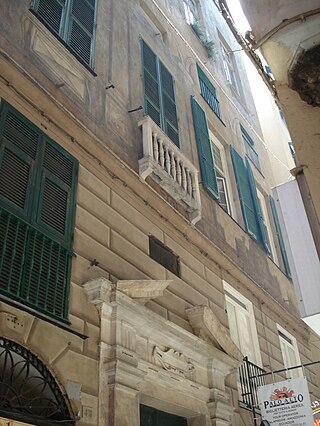
The Palazzo Stefano De Mari is a building located in Via San Luca in the Mercato di Banchi area in the historic centre of Genoa. On 13 July 2006 it was included in the list of the 42 palaces inscribed in the Rolli di Genova that became World Heritage sites announced by UNESCO.

The Palazzo Cosma Centurione is a building located in the historical centre of Genoa, in Via Lomellini at no. 8, included on 13 July 2006 in the list of the 42 palaces inscribed in the Rolli di Genova that became World Heritage by UNESCO on that date. Also known as the Palazzo Durazzo Pallavicini or Palazzo di Gerolamo III Pallavicino, from the name of its successive owners, due to its architecture and the frescoes preserved inside, it is an outstanding example of Genoese Baroque.
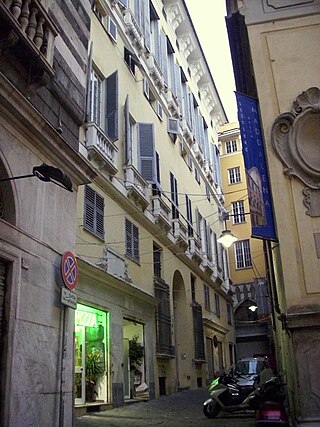
The palazzo Gio Battista Grimaldi is a building located in vico San Luca at no. 4 in the historical centre of Genoa, included on 13 July 2006 in the list of the 42 palaces inscribed in the Rolli di Genova that became World Heritage by UNESCO on that date.

The Palazzo Gerolamo Grimaldi also known as the palazzo della Meridiana is a building located in the salita di San Francesco at number 4 in the historical centre of Genoa, included on 13 July 2006 in the list of the forty-two palaces inscribed in the Rolli di Genova that became World Heritage by UNESCO on that date.

The Palazzo Giacomo Lomellini, also known as the Palazzo Patrone, is a building located in Largo Zecca at number 2 in Genoa, included on 13 July 2006 in the list of the 42 palaces inscribed in the Rolli di Genova that became World Heritage by UNESCO on that date.

The palazzo Belimbau, also known as palazzo Antoniotto Cattaneo or Palazzo Francesco De Ferrari, is a building located in Piazza della Nunziata at number 2 in Genoa, included on 13 July 2006 in the list of the 42 palaces inscribed in the Rolli di Genova that became World Heritage by UNESCO on that date.
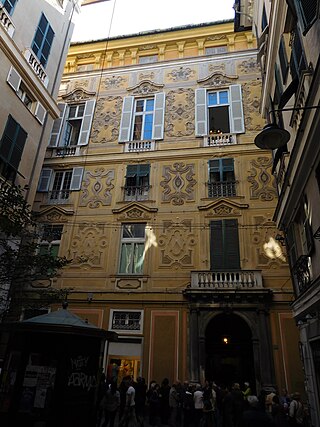
The Palazzo Nicolò Spinola di Luccoli, also called Palazzo del Marchese Stefano Franzone, or Palazzo Spinola Franzone, is a building located in Via Luccoli at number 23, in the area of the Soziglia Market in the historic centre of Genoa. The building was included in the list of palaces inscribed in the Rolli di Genova. The architecture, the decoration of the façade and the frescoes by Domenico Parodi in some of the interior rooms make it a relevant example of Genoese Baroque.

The Palazzo Cristoforo Spinola is a building located in Piazza della Nunziata at number 6 in the historical centre of Genoa. The building was included, and still is, in the list of palaces inscribed in the Rolli di Genova.
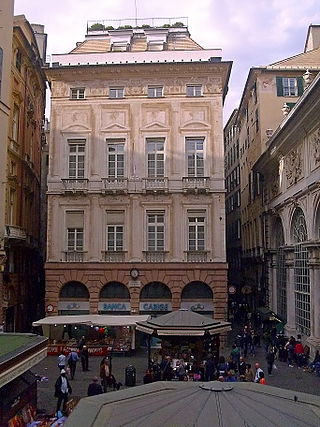
The Palazzo Ambrogio Di Negro is a building located in Via San Luca at number 2 in the area of the Mercato di Banchi in the historic centre of Genoa, included on 13 July 2006 in the list of the 42 palaces enrolled in the Rolli di Genova that became World Heritage by UNESCO on that date. It preserves an important Mannerist painting cycle inside. In front of the palace is the Loggia dei Mercanti (Genoa) and the Church of San Pietro in Banchi.


























